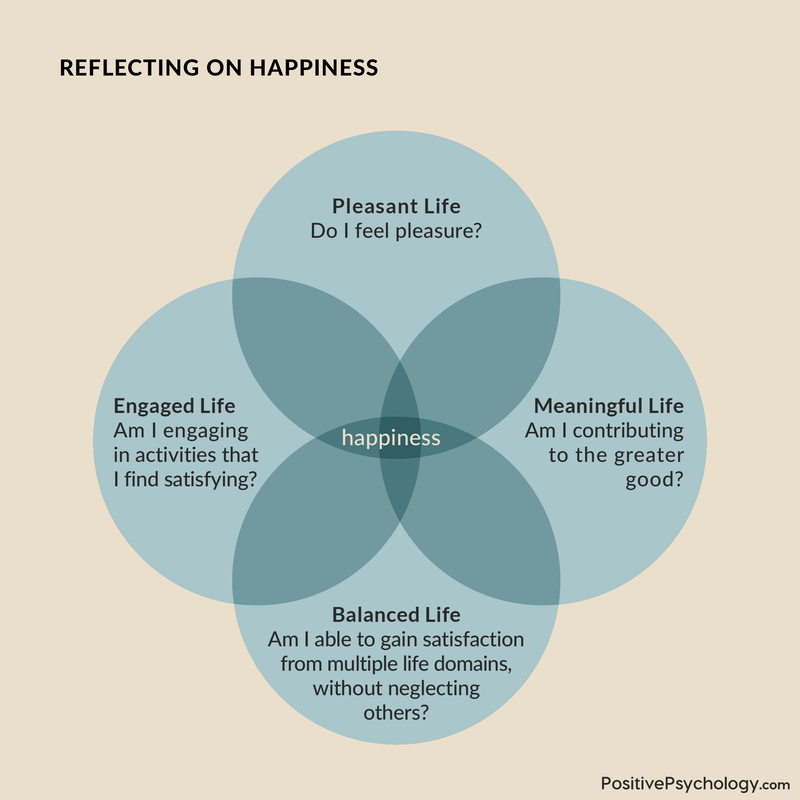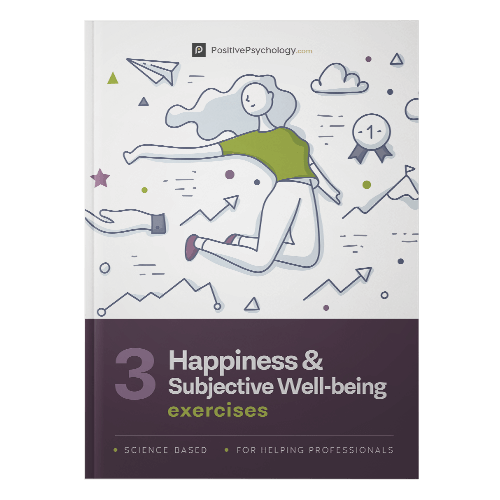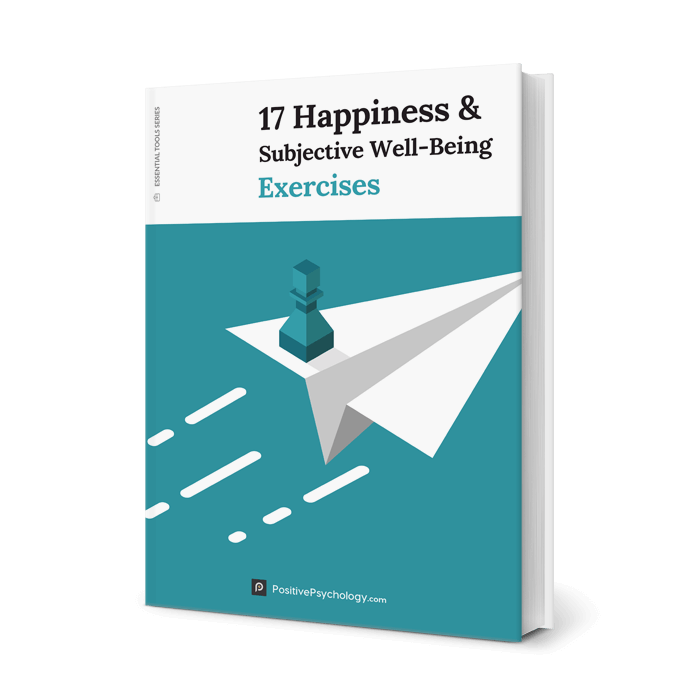What Is Happiness and Why Is It Important? (+ Definition)
 What is happiness?
What is happiness?
It seems like an odd question, but is it? Do you know how to define happiness? Do you think happiness is the same thing to you as it is to others?
What’s the point of it all? Does it even make a difference in our lives?
In fact, happiness does have a pretty important role in our lives, and it can have a huge impact on the way we live our lives. Although researchers have yet to pin down the definition or an agreed-upon framework for happiness, there’s a lot we have learned in the last few decades.
This article will dive into the science of happiness, what it actually is, and why it matters.
Before you continue, we thought you might like to download our three Happiness & Subjective Wellbeing Exercises for free. These detailed, science-based exercises will help you or your clients identify sources of authentic happiness and strategies to boost wellbeing.
This Article Contains:
- A Look at the Oxford English Dictionary’s Definition of Happiness
- What is the Meaning of Happiness in Positive Psychology?
- The Psychology Behind Human Happiness
- 8 Examples That Describe What a Happy Life Looks Like
- Why is Happiness So Important?
- 6 Videos That Explain Happiness
- A Take-Home Message
- References
A Look at the Oxford English Dictionary‘s Definition of Happiness
First, let’s take a look at the definition of happiness so we’re all on the same page. Oxford English Dictionary’s definition of “happiness” is a simple one: “The state of being happy.”
Not exactly what we were looking for, was it? Perhaps we need to dive a little deeper. Oxford English Dictionary’s definition of “happy” is a little more helpful: “Feeling or showing pleasure or contentment.”
That’s better! So, happiness is the state of feeling or showing pleasure or contentment. From this definition, we can glean a few important points about happiness:
- Happiness is a state, not a trait; in other words, it isn’t a long-lasting, permanent feature or personality trait, but a more fleeting, changeable state.
- Happiness is equated with feeling pleasure or contentment, meaning that happiness is not to be confused with joy, ecstasy, bliss, or other more intense feelings.
- Happiness can be either feeling or showing, meaning that happiness is not necessarily an internal or external experience, but can be both.
Now we have a better grasp on what happiness is—or at least, how the Oxford English Dictionary defines what happiness is. However, this definition is not the end-all, be-all definition of happiness. In fact, the definition of happiness is not a “settled” debate.
What is the Meaning of Happiness in Positive Psychology?
The meaning of happiness in Positive Psychology really depends on who you ask.
Happiness is often known by another name in positive psychology research: subjective wellbeing, or SWB.
Some believe happiness is one of the core components of SWB, while others believe happiness is SWB. Regardless, you’ll frequently find SWB used as a shorthand for happiness in the literature.
And speaking of the literature, you will find references to SWB everywhere. A quick Google search for the word “happiness” offers over 2 million results (as of January 6th, 2019). Further, a scan for the same term in two of psychology’s biggest online databases (PsycINFO and PsycARTICLES) returns 19,139 results from academic and other journals, books, dissertations, and more.
Is it difficult to define scientifically?
With so many takes on happiness, it’s no wonder that happiness is a little difficult to define scientifically; there is certainly disagreement about what, exactly, happiness is.
According to researchers Chu Kim-Prieto, Ed Diener, and their colleagues (2005), there are three main ways that happiness has been approached in positive psychology:
- Happiness as a global assessment of life and all its facets;
- Happiness as a recollection of past emotional experiences;
- Happiness as an aggregation of multiple emotional reactions across time (Kim-Prieto, Diener, Tamir, Scollon, & Diener, 2005).
Although they generally all agree on what happiness feels like—being satisfied with life, in a good mood, feeling positive emotions, feeling enjoyment, etc.—researchers have found it difficult to agree on the scope of happiness.
However, for our purposes in this piece, it’s enough to work off of a basic definition that melds the OED‘s definition with that of positive psychologists: happiness is a state characterized by contentment and general satisfaction with one’s current situation.
Pleasure vs. happiness

The association between the two makes sense, and it’s common to hear the two words used interchangeably outside of the literature; however, when it comes to the science of positive psychology, it is important to make a distinction between the two.
Happiness, as we described above, is a state characterized by feelings of contentment and satisfaction with one’s life or current situation. On the other hand, pleasure is a more visceral, in-the-moment experience. It often refers to the sensory-based feelings we get from experiences like eating good food, getting a massage, receiving a compliment, or having sex.
Happiness, while not a permanent state, is a more stable state than pleasure. Happiness generally sticks around for longer than a few moments at a time, whereas pleasure can come and go in seconds (Paul, 2015).
Pleasure can contribute to happiness, and happiness can enhance or deepen feelings of pleasure, but the two can also be completely mutually exclusive. For example, you can feel a sense of happiness based on meaning and engagement that has nothing to do with pleasure, or you could feel pleasure but also struggle with guilt because of it, keeping you from feeling happy at the same time.
Happiness vs. meaning
Happiness and meaning have an even more distinct line between the two. Rarely are happiness and meaning confused or used interchangeably, and for good reason—they describe two very different experiences.
Humans may resemble many other creatures in their striving for happiness, but the quest for meaning is a key part of what makes us human, and uniquely so.
Roy Baumeister et al. (2013)
Unlike happiness, meaning is not a fleeting state that drifts throughout the day; it’s a more comprehensive sense of purpose and feeling of contributing to something greater than yourself.
As the quote from Baumeister and colleagues (2013) suggests, there are important distinctions between the methods of searching for and the benefits of experiencing happiness and meaning. Scott Barry Kaufman at Scientific American (2016) outlines these distinctions that Baumeister and his fellow researchers found between the two:
- Finding one’s life easy or difficult was related to happiness, but not meaning;
- Feeling healthy was related to happiness, but not meaning;
- Feeling good was related to happiness, not meaning;
- Scarcity of money reduced happiness more than meaning;
- People with more meaningful lives agreed that “relationships are more important than achievements;”
- Helping people in need was linked to meaning but not happiness;
- Expecting to do a lot of deep thinking was positively related to meaningfulness, but negatively with happiness;
- Happiness was related more to being a taker rather than a giver, whereas meaning was related more to being a giver than a taker;
- The more people felt their activities were consistent with the core themes and values of their self, the greater meaning they reported in their activities;
- Seeing oneself as wise, creative, and even anxious were all linked to meaning but had no relationship (and in some cases, even showed a negative relationship) to happiness (Kaufman, 2016).
Basically, although the two overlaps and each can contribute to the experience of the other, the two can be mutually exclusive (Baumeister et al., 2013).
Relevant reading: 19 Cliché Happiness Quotes & The (Lack Of) Science Behind Them
The origins and etymology of happiness (Incl. root words)
According to Etymology Online (n.d.), the word for “happy” in most languages came from the word for “lucky.” This suggests an interesting trend—perhaps our ancestors believed that happiness was largely a by-product of luck?
It also points to a possible difference of general opinion between earlier generations and our own 20th and 21st-century generations: that happiness was not a vital factor in a good life, but essentially a bonus that some lucky individuals got to experience.
Here’s what author Darrin McMahon writes about the origins and root words of the word “happiness:”
“It is a striking fact that in every Indo-European language, without exception, going all the way back to ancient Greek, the word for happiness is a cognate with the word for luck. Hap is the Old Norse and Old English root of happiness, and it just means luck or chance, as did the Old French heur, giving us bonheur, good fortune or happiness. German gives us the word Gluck, which to this day means both happiness and chance.”
(McMahon, 2006)
What does self-happiness mean?
Although the term is not used very often, “self-happiness” refers to a sense of happiness or satisfaction with one’s self. It is often associated with self-confidence, self-esteem, and other concepts that marry “the self” with feeling content and happy.
In general, it means that you are pleased with yourself and your choices, and with the person that you are.
Happiness can be defined as an enduring state of mind consisting not only of feelings of joy, contentment, and other positive emotions, but also of a sense that one’s life is meaningful and valued (Lyubomirsky, 2001).
Happiness energizes us and is a highly sought after state of being. But, what components make up happiness?
Martin Seligman (2002) argued that happiness has three dimensions that can be cultivated:
- The regular experience of pleasantness (the pleasant life)
- The frequent engagement in satisfying activities (the engaged life)
- The experience of a sense of connectedness to a greater whole (the meaningful life)
Although each dimension is important, the happiest people tend to be those who pursue the full life— they infuse their life with pleasure, engagement, and meaning (Seligman et al., 2005).
Building on Seligman’s three dimensions of happiness, Sirgy and Wu (2009) added the balanced life dimension.
According to these authors, balance in life is another key factor contributing to happiness because the amount of satisfaction derived from a single life domain is limited. One needs to be involved in multiple domains to satisfy the broad spectrum of human needs. As a result, cultivating a sense of balance is crucial for juggling these life domains.

The Psychology Behind Human Happiness
Now that we know what happiness is, let’s dive a little deeper. What does psychology have to tell us about happiness?
There are many different theories of happiness, but they generally fall into one of two categories based on how they conceptualize happiness (or well-being):
- Hedonic happiness/well-being is happiness conceptualized as experiencing more pleasure and less pain; it is composed of an affective component (high positive affect and low negative affect) and a cognitive component (satisfaction with one’s life);
- Eudaimonic happiness/well-being conceptualizes happiness as the result of the pursuit and attainment of life purpose, meaning, challenge, and personal growth; happiness is based on reaching one’s full potential and operating at full functioning (AIPC, 2011).
Some theories see happiness as a by-product of other, more important pursuits in life, while others see happiness as the end-goal for humans. Some theories state that pursuing happiness is pointless (although pursuing other important experiences and feelings may contribute to greater happiness), and some assume that happiness can be purposefully increased or enhanced.
Although they differ on the specifics, these theories generally agree on a few points:
- It’s good to be happy, and people like being happy;
- Happiness is neither a totally fleeting, momentary experience nor a stable, long-term trait;
- At least some portion of our happiness is set by our genetics, but the amount varies from about 10% up to 50%;
- The pursuit and attainment of pleasure will rarely lead to happiness;
- There are many sources that contribute to or compose happiness (AIPC, 2011).
What sources create true personal happiness?
Taking together all the various theories and findings on happiness, we know that there are at least a few factors that are very important for overall happiness:
- Individual income;
- Labor market status;
- Physical health;
- Family;
- Social relationships;
- Moral values;
- Experience of positive emotions (AIPC, 2011).
All of these factors can contribute to a happy life, but research has found that good relationships are a vital ingredient (Waldinger & Schulz, 2010).
When we are happy in our most important relationships (usually our spouse or significant other, our children and/or our parents, other close family members, and our closest friends), we tend to be happier.
We have some control over how our relationships go, so that leads us to an interesting and important question: can we increase our own happiness?
Can individuals learn how to be happy?
The answer from numerous studies is a resounding YES—you CAN learn how to be happier.
The degree to which you can increase your happiness will vary widely by which theory you subscribe to, but there are no credible theories that allow absolutely no room for individual improvement. To improve your overall happiness, the most effective method is to look at the list of sources above and work on enhancing the quality of your experiences in each one of them.
For example, you can work on getting a higher salary (although a higher salary will only work up to about $75,000 USD a year), improve your health, work on developing and maintaining high-quality relationships, and overall, find ways to incorporate more positive feelings into your daily life. This does assume basic access to safety as well as social equality.
8 Examples That Describe What a Happy Life Looks Like

Of course, what it looks like will depend on the individual—a happy life for one person may be another’s nightmare!
However, there are a few examples that can display a wide range of lives that can be conducive to happiness:
- A woman who lives alone, has excellent relationships with her nieces and nephews, gives to charity, and finds meaning in her work;
- A man who is happily married with three healthy children and a relatively low-paying job;
- A widow who enjoys regular visits with her children and grandchildren, along with volunteering for local charities;
- A cancer patient who has a wonderful support system and finds meaning in helping others make it through chemotherapy;
- A social worker who works 70-hour weeks with no overtime pay, to ensure the children on her caseload are in good hands;
- An unmarried man in a monastery who has no earthly possessions and no salary to speak of, but finds meaning in communing with his god;
- A teenager in a foster home who has several close friends and enjoys playing football on his school’s team;
- A man who lives with several pets, enjoys a high salary, and loves his job.
Each of these was pulled from real-world examples of people who are happy. They may not seem like they have it all, but they all have at least one of the ingredients from the list of sources mentioned earlier. We don’t need to have everything we want in order to be happy—true happiness can be obtained by finding joy in what we already have, however much or little that may seem.
What are some visions you associate with happiness? Are there any similarities with these dreams?
Why is Happiness So Important?
You might be wondering why happiness is considered such an important aspect of life, as there are many components of a meaningful life.
In some ways, science would agree with you. It appears that life satisfaction, meaning, and well-being can be linked with happiness, but happiness is not necessarily the overarching goal for everyone in life. It is still important because it has some undeniably positive benefits and co-occurring factors.
June Silny at Happify outlines 14 answers to the question, “What’s so great about happiness, anyway?”
- Happy people are more successful in multiple life domains, including marriage, friendship, income, work performance, and health.
- Happy people get sick less often and experience fewer symptoms when they do get sick.
- Happy people have more friends and a better support system.
- Happy people donate more to charity (and giving money to charity makes you happy, too).
- Happy people are more helpful and more likely to volunteer—which also makes you happier!
- Happy people have an easier time navigating through life since optimism eases pain, sadness, and grief.
- Happy people have a positive influence on others and encourage them to seek happiness as well, which can act as reinforcement.
- Happy people engage in deeper and more meaningful conversations.
- Happy people smile more, which is beneficial to your health.
- Happy people exercise more often and eat more healthily.
- Happy people are happy with what they have rather than being jealous of others.
- Happy people are healthier all around and more likely to be healthy in the future.
- Happy people live longer than those who are not as happy.
- Happy people are more productive and more creative, and this effect extends to all those experiencing positive emotions.
The relationship between mental health and happiness
As you can probably assume from the list above, there is a strong relationship between mental health and happiness! When happy people are healthier, have better relationships, make friends more easily, and find more success in life, it’s easy to see why happiness and mental health are related.
The sources that contribute to happiness are the same as those that provide people with a buffer or protection against mental illness, which explains the close relationship between the two.
A recent study explored the association between happiness and mental health in college students and found that a relatively strong, positive correlation connects the two factors (Shafiq, Nas, Ansar, Nasrulla, Bushra, & Imam, 2015). This correlation held, even when gender and socio-demographic variables were added to the mix.
The close tie between mental health and happiness is reason enough to make happiness an important priority for parents, educators, researchers, and medical professionals alike, along with the simple fact that we all like to feel happy!
6 Videos That Explain Happiness
If you’re interested in learning more about happiness from a scientific perspective, there are a few videos you might want to check out, including:
Positive Psychology: The Science of Happiness by Professor Tal Ben-Shahar from WGBH Forum.
Shawn Achor – The Happiness Advantage: Linking Positive Brains to Performance TEDTalk from TEDx Talks
Positive Psychology – Happier by Professor Tal Ben-Shahar, Ph.D. from FightMediocrity
How to be Happy – The Science of Happiness and Feeling Positive in Life from Memorize Academy
The Surprising Science of Happiness TED Talk by Dan Gilbert from TED
How to Be Happy – The Secret of Authentic Happiness – Martin Seligman from Practical Psychology
A Take-Home Message
I hope this piece was helpful and informative for you, and that you learned something new about the scientific study of happiness. It’s a fascinating area of research, and new findings are coming out all the time. Make sure you stay up to date on the happiness literature, as the findings can be of great use in helping you to live your best life!
What are your thoughts on happiness? Would you define it differently? What do you find is the most important ingredient for your own happiness? Let us know in the comments section below!
Thanks for reading, I hope you are all finding happiness in all your life journeys.
We hope you enjoyed reading this article. Don’t forget to download our three Happiness Exercises for free.
- AIPC. (2011). Happiness and positive psychology. Australian Institute of Professional Counsellors Article Library. Retrieved from https://www.aipc.net.au/articles/happiness-and-positive-psychology/
- Baumeister, R., Vohs, K. D., Aaker, J. L., & Gabinsky, E. N. (2013). Some key differences between a happy life and a meaningful life. The Journal of Positive Psychology, 8, 505-516.
- Joseph Sirgy, M., & Wu, J. (2009). The pleasant life, the engaged life, and the meaningful life: What about the balanced life? Journal of Happiness Studies, 10, 183-196.
- Kaufman, S. B. (2016). The differences between happiness and meaning in life. Scientific American. Retrieved from https://blogs.scientificamerican.com/beautiful-minds/the-differences-between-happiness-and-meaning-in-life/
- Kim-Prieto, C., Diener, E., Tamir, M., Scollon, C. N., & Diener, M. (2005). Integrating the diverse
definitions of happiness: A time-sequential framework of subjective well-being. Journal of Happiness Studies, 6, 261-300. - Lyubomirsky, S. (2001). Why are some people happier than others? The role of cognitive and motivational processes in well-being. American Psychologist, 56(3), 239.
- McMahon, D. (2006). Happiness: A history. Grove Press.
- Online Etymology Dictionary (n.d.). Happy. Retrieved from http://plato.stanford.edu/entries/behaviorism/
- Paul, M. (2015). The difference between happiness and pleasure. Huffington Post: Life. Retrieved from https://www.huffpost.com/entry/the-difference-between-happiness-and-pleasure_b_7053946
- Seligman, M. E. (2002). Authentic happiness: Using the new positive psychology to realize your potential for lasting fulfillment. Simon and Schuster.
- Seligman, M. E., Steen, T. A., Park, N., & Peterson, C. (2005). Positive psychology progress: empirical validation of interventions. American Psychologist, 60(5), 410.
- Shafiq, S., Naz, R. A., Ansar, M., Nasrulla, T., Bushra, M., & Imam, S. (2015). Happiness as related to mental health among university students. International Journal of Humanities and Social Science, 5, 124-132.
- Silny, J. (n.d.). What’s so great about happiness, anyway? (The answer: plenty!). Happify Daily. Retrieved from https://www.happify.com/hd/whats-so-great-about-happiness/
- Waldinger, R. J., & Schulz, M. S. (2010). What’s love got to do with it?: Social functioning, perceived health, and daily happiness in married octogenarians. Psychology and Aging, 25, 422-431.
Let us know your thoughts
Read other articles by their category
- Body & Brain (49)
- Coaching & Application (57)
- Compassion (26)
- Counseling (51)
- Emotional Intelligence (24)
- Gratitude (18)
- Grief & Bereavement (21)
- Happiness & SWB (40)
- Meaning & Values (26)
- Meditation (20)
- Mindfulness (45)
- Motivation & Goals (45)
- Optimism & Mindset (34)
- Positive CBT (29)
- Positive Communication (20)
- Positive Education (47)
- Positive Emotions (32)
- Positive Leadership (18)
- Positive Parenting (4)
- Positive Psychology (33)
- Positive Workplace (37)
- Productivity (17)
- Relationships (46)
- Resilience & Coping (36)
- Self Awareness (21)
- Self Esteem (38)
- Strengths & Virtues (32)
- Stress & Burnout Prevention (34)
- Theory & Books (46)
- Therapy Exercises (37)
- Types of Therapy (64)





What our readers think
good !
His article was extremely helpful and enabled me to grasp the concept of the confusing question of what it means to be happy and the general meaning of happiness.
I’m so glad I found this article to be honest.
I disagree with your comment that ‘Happiness is not a state but a trait.’ I see happiness as a purely internal construct. I choose to be happy regardless of the people or things going on around me. Those people who look for happiness in others, outside of themselves, bounce back and forth between some fleeting form of happiness and unhappiness. If they would instead see happiness as an internal construct, man vs himself, they wouldn’t be dependent on someone else for their personal feelings of happiness. Because really, you don’t have the power to change others… But you do have all the power you need to change how you choose to see and react to what’s around you. The ball of your happiness is 100% in your court.
The article was very helpful and informative
Just finished your article on happiness, or SWB and meaning . As stated in your article, happiness is fleeting and subject to feel good material goods and personal objectives. Having sex, kids, buying a new car, an opioid response. However, I thought life was supposed to have meaning that would contribute to my happiness. I chose a career based on what I thought I could contribute to my own and others lives. Rather naïve on my behalf and futile at this stage. I’m 72 years old and understand less now about the world as it is than ever before. I’ve seen the horrors of war and have moved forward from those days to marrying, having a family and building a career, the dopamine response, however I’ve lost the meaning of life and find myself unhappy, angry, reclusive and frustrated. I have done drugs, tried meditation and read books searching for meaning and happiness, which has been elusive at times. Your article helped put certain expectations of others and myself in perspective and what I need to do to achieve happiness and meaning. Thank you!
Thanks for this article.
Nowadays, i do gratitude exercice in the morning, midday and before sleep. It’s help me stay more in positive thoughts. I like soo much.
I write: I am grateful for … ( 10x )
Thank you so much for this very insightful article. It really taught me a lot.
Thank you very much for the article. I think it will help me a lot. It has given me clear ideas of how I can try and attain some degree of happiness, and hence greater contentment. Happiness is important in individuals – I believe it is a key to tolerance and a stable society.